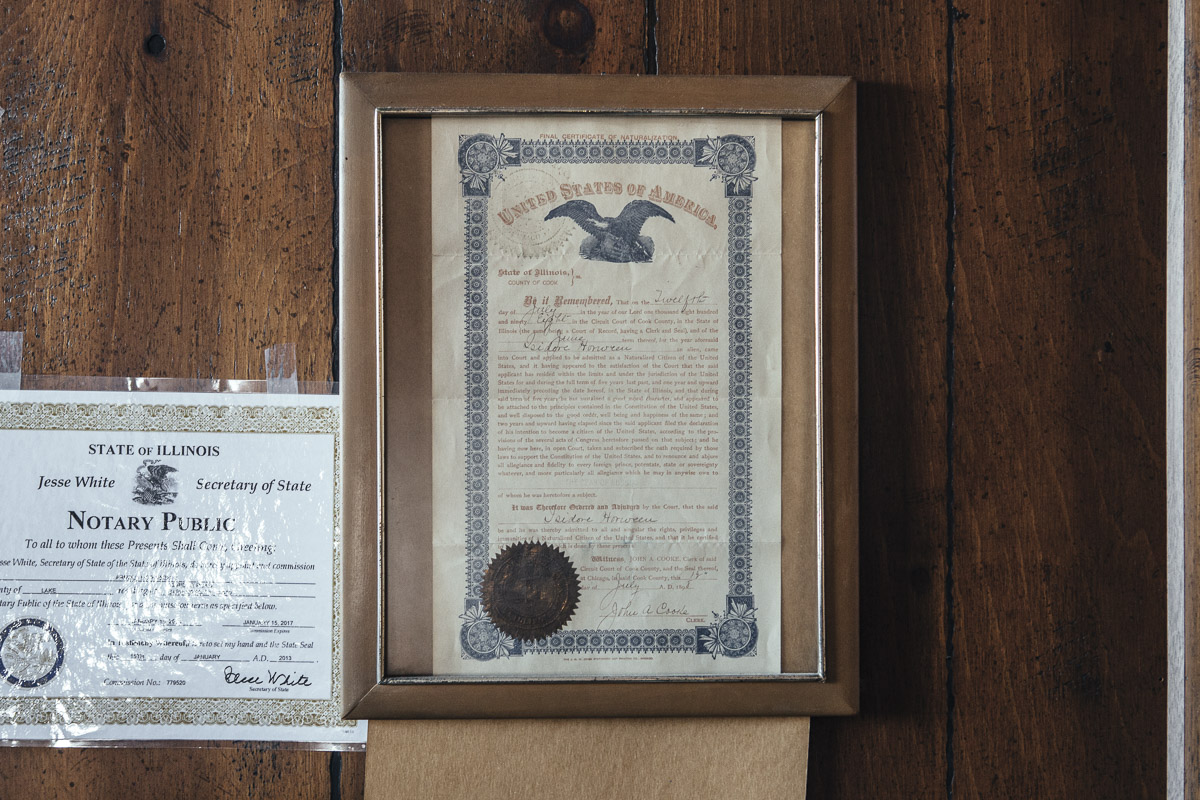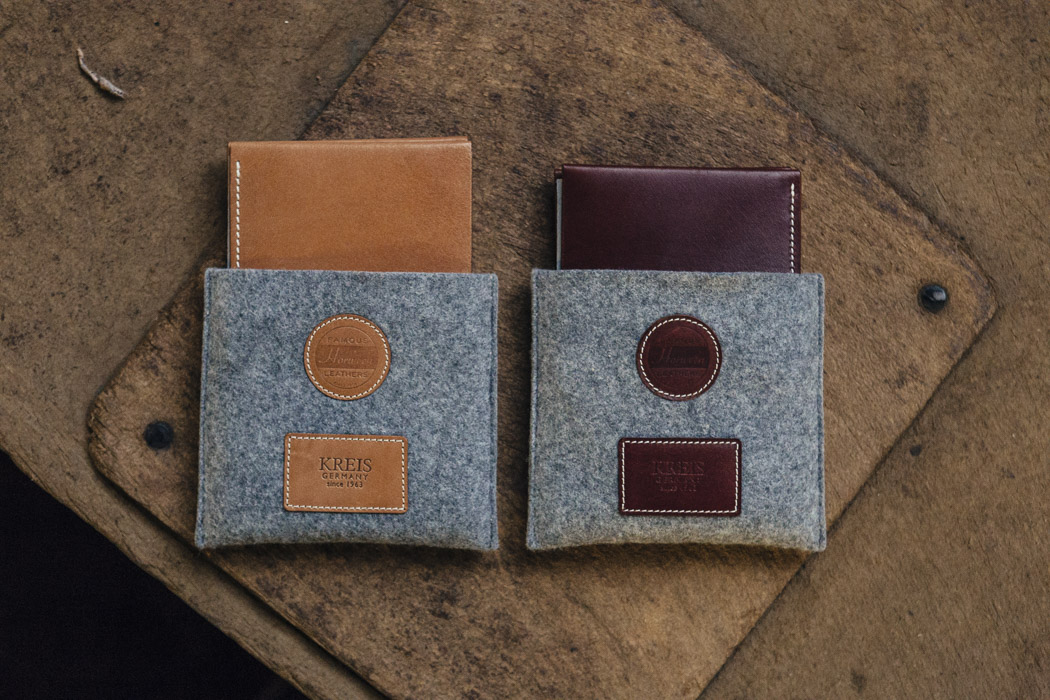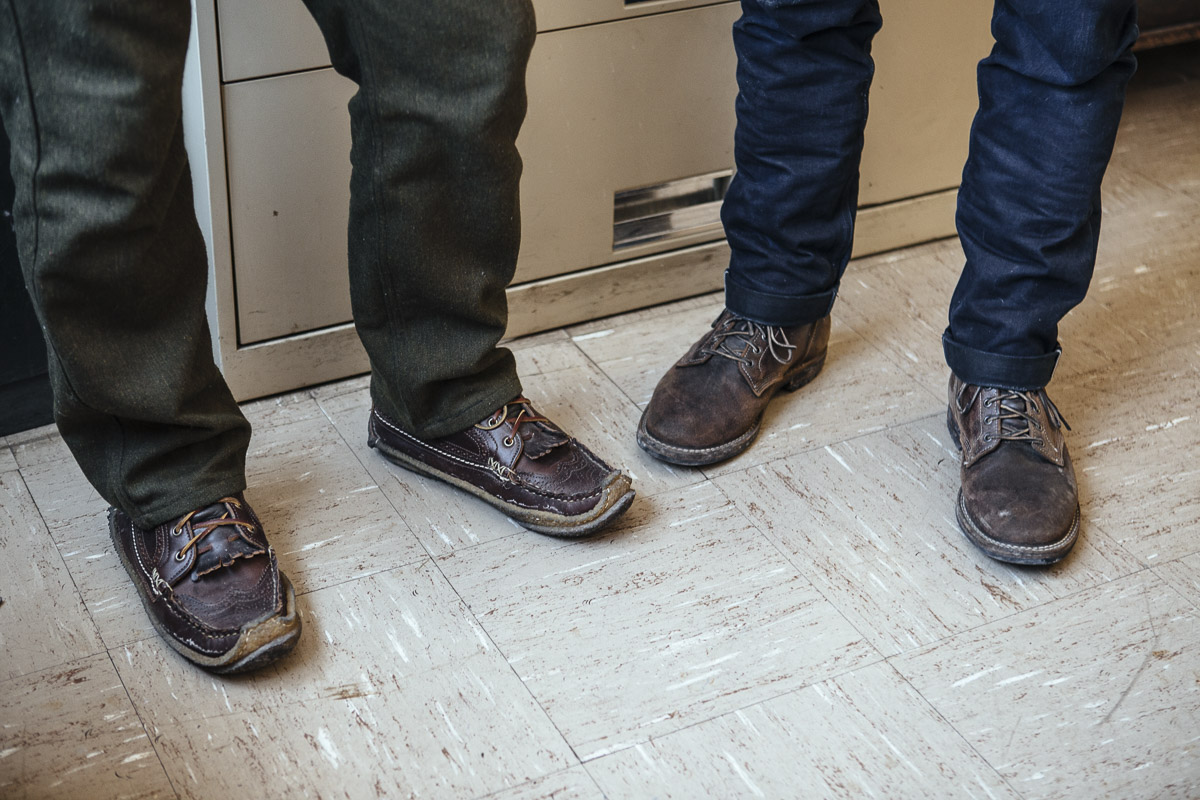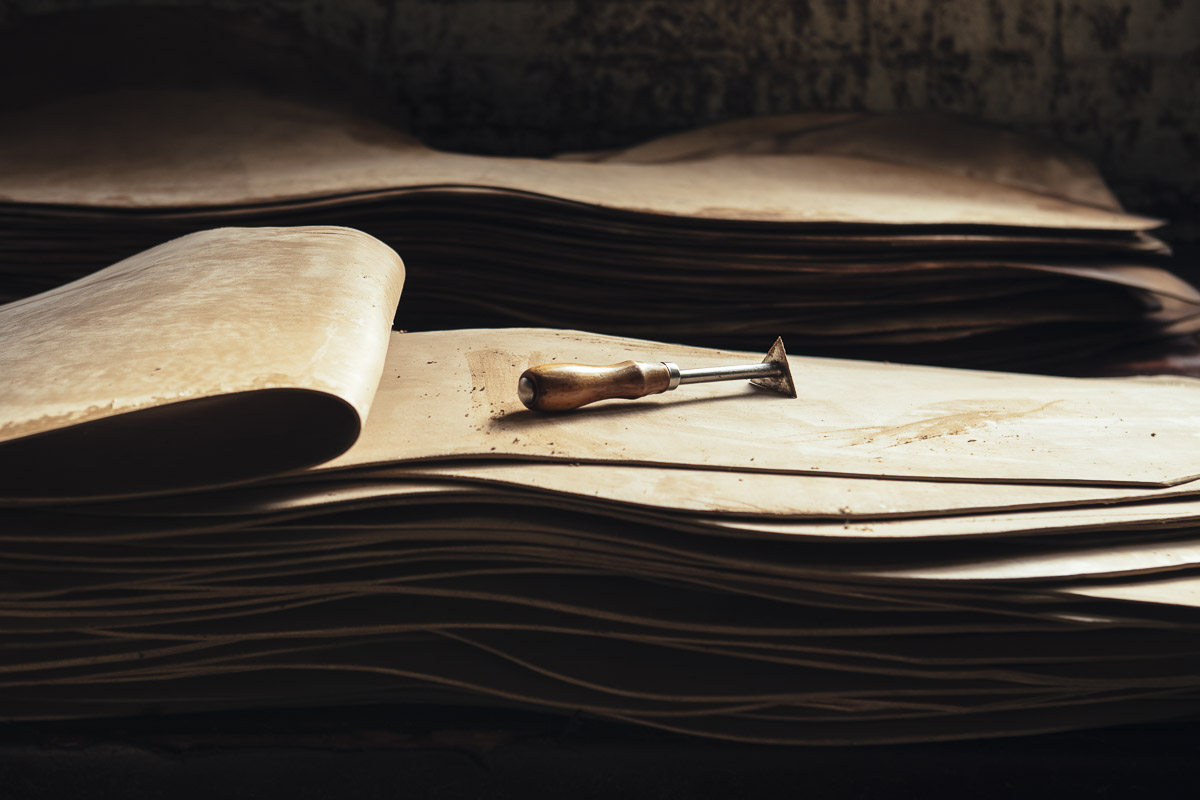I’m holding a leather key case that belonged to Nick Horween’s great-great grandfather, Isidore Horween, who founded the Horween Leather Company in 1905. The shell-cordovan leather shines in the overhead light, still oily after however many decades. On the cover, gold-stamped letters—no cracks, no fading—spell Isidore’s name. The zipper has retained a satisfying crunch, and the original key clasps hang neatly in a row.
As Nick Horween describes the key case and the rest of the items that he’s pulled from the Horween archives for our visit today, he never uses the words “heritage” or “tradition.” He doesn’t wax lyrical about artisanal production or breathlessly extoll the virtues of all things handmade. There are no stories about leather saving the world, no defiant stand taken for American manufacturing.
Which is to say: Even though Horween leather features prominently in the world of menswear, Nick and the rest of his family don’t contribute to the hype so prevalent in that world. Instead, they follow a long, legitimate family tradition of quietly going about their business, making some of the best leather on the market.
As Nick’s father, Arnold “Skip” Horween III, puts it, Horween makes leather that other tanneries “don’t, won’t, or can’t.” Explaining the company’s emphasis on quality, Skip says, “We learn, as we do new things, how to make things as good as they can be. We don’t know how to take just enough out, so it’s just good enough.”
Why not settle for good enough? The answer is in my hands. Good enough doesn’t get you this key case. Or the long wallet from Pierre Cardin that dates to the 1950s. Or my favorite of the items that we’ll see today: the beautiful, bizarre “fish bag” from Germany, with its buttery leather and oblong silhouette. (Admittedly, in addition to the quality of leather, quality of construction also contributes to the longevity of items in the Horween archives. Master craftsmen, it would seem, prefer superior materials.)
As Nick takes us through the archives, we’ll notice a recurring theme: many of the items were made with shell cordovan, one of Horween’s most famous leathers—starting with a collection of personal effects.

A brief introduction to the Horween Leather Company's premier product offering.
Isidore Horween invented the formula for Horween shell cordovan. Known for his innovation, Isidore also formulated the recipe for Horween’s popular Chromexcel leathers. “He was the hardest-working, smartest guy I've ever heard of,” Nick says. “He started the business and in 15 years grew it big enough to be able to expand to a different building.”
Under Isidore’s guidance, the business outgrew its original home on Division Street, and in 1920 all operations moved to the current location on Elston Avenue, where the company has been headquartered for the last 95 years. As the Horween patriarch, Isidore goes down in the family tree as father to Arnold Sr., grandfather to Arnold Jr., great-grandfather to Skip, and great-great grandfather to Natalie and Nick.

Leather isn't the only material at Horween that tells a story. On Skip's wall hangs a cherished piece of paper.
“That would have belonged to my great-grandfather (Arnold Horween Sr.),” Nick says of the long wallet. “He went to Harvard and then coached football at Harvard, so he was a very upstanding fellow. In all the pictures I have of him, he's either in football get-up because he's playing or coaching—or he’s in a suit with a fedora and long coat.”
Made by Pierre Cardin in the 1950s, the long wallet was clearly designed with the “upstanding fellow” in mind. The design is sleek and simple—you could even say elegant. This isn’t a wallet you'd leave sticking out of a back jeans pocket. Arnold Sr.’s outerwear and suit jackets, however, would have had interior pockets where this wallet would fit perfectly.
Arnold Sr. helmed the Horween business long before the era of business casual. He dressed accordingly, in suits and top coats. Of course, back in those days people also puffed like chimneys, the Horweens included. As Nick says, “Up until my father, everyone in the family smoked."
This cigarette case belonged to Arnold Sr. It matched his long wallet, and—befitting the hard-nosed Harvard football coach—was designed for unfiltered cigarettes. Amity Leather made the cigarette case in 1945. The Zippo came a little later. “I went onto Zippo’s website and dated it,” Nick says. “That’s like early fifties. I was talking to our old CFO who's now retired, and they used to order crates of cigarettes for the office. From Zippo they would get those lighters with the logo on it. Everyone would have one.”
When we talk about the Horween “archives,” there aren’t any vaults or white gloves, just an unassuming row of cabinets in a side room near the Horween front offices. During our visit, Nick gave us the chance to dig into those cabinets and pick our own favorites from Horween’s illustrious past. We pulled two bags: one a masterpiece, the other a mystery.
The newest of all the pieces in our story, the briefcase dates to the early 2000s. Kreis Ledermanufaktur, a second-generation family business outside of Frankfurt, made the bag for Skip Horween. This is the Beta I model that Kreis still makes to order—by hand and from scratch—to the tune of $4,800. When considering the price, bear in mind that the entire case consists of shell cordovan. Nick estimates that the bag includes $800 of leather alone.
Explaining the level of detail that goes into Kreis products, Nick refers to the company’s work with exotic leathers, telling us:
“They're really well-known for their belts, and they do hand-skived hornback and gator so that the scales fit perfectly together. You've got the same-size scales all the way around. It's pretty intense stuff. He (Bernd Kreis, son of the company founder) is one of the best small leather-goods makers that I know. His attention to detail and how he figures out how to do things is really unique.”
The same level of intensity—and maybe even some of the same exotic materials—went into the briefcase. “It’s a full cordovan briefcase,” Nick says, “and (Kreis) always lines pieces like this with either really nice English veg, or kangaroo, or something way over the top, and then hand-fits all the locks.”
No one knows who made the “fish bag.” It got its name because someone at Horween thought it looked well-suited for carrying the day’s catch. Skip tells us it was actually intended as a weekender. “It was made by a small maker in Germany,” he says. “His idea was that it was a bag you’d put in the back of your car for weekend trips. I’ve never seen anything like it.” The bag, made with Horween’s Latigo leather, dates to the 1990s. If you recognize it and know the identity of the maker, please drop us a line. We wouldn't mind having one for ourselves.

Nick's uncle took the recipe for this leather to his grave. How's that for "limited edition"?
Nick selected four shoes, three of which belonged to his grandfather, Arnold Horween Jr. Describing his grandfather as a “quality guru,” Nick says that Arnold Jr. took the family’s product-quality commitment to a new level. “He didn't care what steps it added—he would go around and tell you to do something the way he wanted,” Nick says. “He knew that it would make it better, and there was no compromising with his personality.”
Casual, dress, and work—those are the three areas covered by Arnold Jr.’s trio of shoes. Starting with the casual, we have his loafers. These days, Horween leather goes into loafers from Oak Street Bootmakers, Quoddy, New England Outerwear, Yuketen, Rancourt & Co., et al. Few of the contemporary designs, however, match Arnold Jr.’s loafers in terms of complexity and nuance.
“The loafers are interesting because it’s really a Venetian loafer with a faux penny strap,” Nick says. “Then there’s that skin skitch at the top. A lot of work goes into making a shoe like that. It’s all one piece with no collar, so it’s a pretty quirky shoe when you start paying attention to it.” The company behind the intricate construction is Florsheim. During the 1950s, Florsheim manufactured in Chicago, meaning that these shoes were all–Windy City, from the leather and manufacturing to Arnold Jr. wearing them down Elston Avenue.
Also, these shoes might help explain the cordovan / burgundy confusion. This particular cordovan leather was made using Horween’s famous Color #8, which remains popular today.
Earlier we mentioned that shell cordovan is a rather specific type of leather. These shoes, it turns out, were made with a rather specific type of cordovan. “Those are zebra shells,” Nick says. “We're always looking for new horsehide sources, and from time to time, for whatever reason, there are zebras available. So we ended up with some zebra shells, which was never really a viable product. Those are totally a one-off kind of thing.”
Making these shoes even more unique: the whole-cut construction. “It's just one piece (of shell-cordovan leather),” Nick says of the material. “People don't do that, because it's expensive. You have to have a shell that has that big of a pattern." Manufactured at the Walk-Over factory in Bridgewater, Massachusetts, these shoes are labelled Keith Highlander, a brand that no longer exists. Just as you’ll never see another pair of shoes from Keith Highlander, you’ll never see another zebra product from Horween.
As Skip tell us, “I remember when they ran the zebras here. I was a kid. Zebra was one of the alternatives that they looked at when the horsehide availability started to become more difficult. They sent over a couple shells and I think that was all they got out of them, enough for one pair of shoes. Now I'm happier to stay away from stuff like that. They tell you that (the hides are) legitimately taken, but it's hard to check, and we want to do things in a responsible way. I can give you origin (of all current Horween leather) back to the packing house.”
When Arnold Horween Jr. needed to roll up his sleeves and get to work at the family’s summer house in Michigan’s Upper Peninsula, he knocked around in these boots. Made private-label by Chippewa for Herman Shoes, these Horween Chromexcel boots clearly received some quality wear, given the Cat’s Paw and Biltrite additions. (The history of Cat’s Paw is interesting in its own right, as explained in this Styleforum.net thread).

During our tour, Nick answered a few questions about the heritage / workwear / Americana market, and its impact on the Horween business.
Stefano Bemer, the late, great Florentine shoemaker, made these shoes for Skip using non-cordovan Horween horsehide. “He was an awesome guy,” Nick says of Bemer. “Every time there were trade shows in Bologna we’d go down to Florence and just get lunch with him. It was always fun to see what he did. He was full-custom. They’d make a last of your foot, then you could call him at any point and say, ‘I want this leather and this bottom, with these details’ and he’d make the shoes and send them to you.”
Bemer attracted no shortage of celebrity clients, some more passionate than others. Daniel Day Lewis actually worked as an apprentice with Bemer for eight months between 1999 and 2000. Nick dates these shoes to the 1990’s, so they were most likely not worked on by Lewis, the three-time Oscar winner and renowned drinker-upper of milkshakes.
Shoes account for 40 percent of Horween’s overall business. Sporting goods make up another 40 percent, with Horween providing leather for all NFL footballs, NBA basketballs, and Rawlings baseball gloves. In such a tradition-rich company, it’s no surprise that Horween’s sporting heritage goes all the way back to the 1920s, with Arnold Sr.’s glory days on the gridiron.
Arnold Horween Sr. played college football at Harvard, along with his brother, Ralph. In 1919, the Horween boys helped Harvard to an unbeaten record, a feat that The Crimson duplicated the following year. Arnold Sr. closed out 1920 with All-American honors, and his school received a bid to play in the Rose Bowl. During the big game, Arnold Sr. kicked the decisive extra point, helping his team to a 7–6 win against Oregon.
After college, the Horweens went pro, playing for their hometown Chicago Cardinals. (As Wailin Wong mentioned in her comprehensive business profile on Horween for The Distance, Arnold Sr. and Ralph Horween played under the last name McMahon, fearing their mother’s disapproval. And no, former Chicago quarterback Jim McMahon is not secretly a Horween.)
Arnold went on to coach the Cardinals before returning to Harvard to call plays from the sidelines.
During his time with the Cardinals, Arnold Sr. met George Halas, one of the founders of the National Football League and eventual owner of the Chicago Bears franchise. “They played against each other,” Nick says, “and then they had the conversation, like, ‘We could probably make a football using leather that's better than what exists now.’” Halas introduced Arnold Sr. to the folks at Wilson Sporting Goods, and soon afterwards Horween and Wilson formalized a partnership. Seventy-plus years later, Wilson still uses Horween leather for all footballs manufactured for the NFL. When talking about Wilson, Nick says, “I can’t say enough good things about that relationship.”
One well-known attribute of Horween football leather: the grip. How Horween achieves that grip, however, nobody knows. “It’s a trade secret,” Nick says. “In both these cases (the NFL and NBA), leather is better than composites because even if this stuff gets wet, it will wick the moisture from your fingers, so it will never get slippery. It will get heavy eventually, but it will never get to the point that you can't grip it, which is why leather has hung on in the higher levels of both (football and basketball).”
Following its football success, Horween branched out. Today all NBA basketballs are made from Horween leather. Football and basketball leather have different formulations, and, incidentally, different breaking-in processes. “They'll practice with a basketball for six to twelve months before it ever makes it into a game,” Nick says. “By that time, it's dark and almost totally smooth. They don’t do anything like what the football guys do, where they want a new, really sticky, pebbled ball as often as they can because they can catch it better.”
“The way that we make leather and the way Rawlings makes gloves is the old style,” Nick says. “Where our price point is for our leather, even when we're talking about companies like Clarks and Timberland and Wolverine, the companies that are much larger than us that we deal with, we're small. They're big for us but we're small for them. So we're doing their top-end products. It’s the same thing with Rawlings.”

Real-estate developers have repeatedly tried to buy the Horween factory premises. Skip always says "no." When you walk the factory floors, you understand why.
Our original idea was to present an abbreviated history of the Horween Leather Company by looking at products that belonged to each generation of the Horween family. But coming away from the tannery visit, we found ourselves more interested in how all those different generations shared a common core belief: quality first, no exceptions. Without that family creed, there wouldn’t be an archived collection worth talking about in the first place.
To put it in different terms, without the why (obsession with quality) there would be no what (beautiful vintage pieces). Our Horween experience has helped shaped the overall approach for Someone Else. There will always be room for what, and even how, but going forward, we hope to emphasize why whenever possible.

Despite being the flagship for Oak Street Bootmakers, Independence doesn't quite fit in on Oak Street. Timothy Grindle and George Vlagos give us the outsider perspective.